The most comprehensive study to date of the growing universe of partisan websites and Facebook pages about US politics reveals that in 2016 alone at least 187 new websites launched, and that the candidacy and election of Donald Trump has unleashed a golden age of aggressive, divisive political content that reaches a massive amount of people on Facebook.
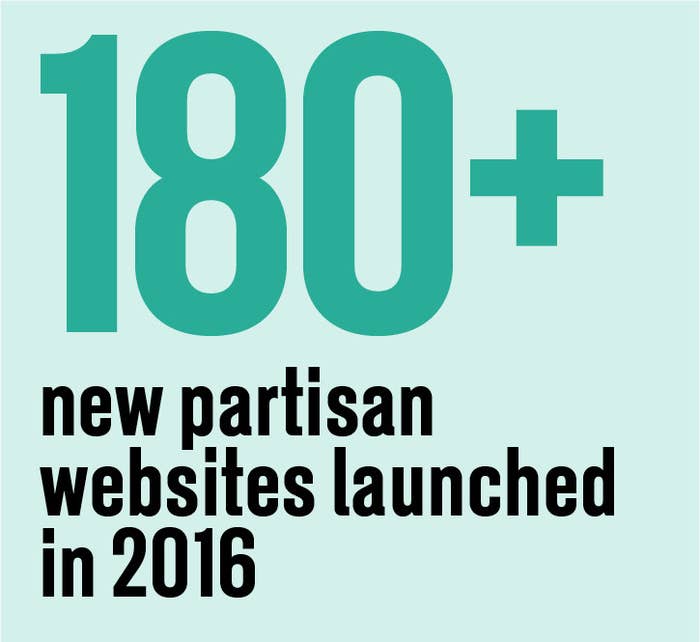
Thanks to a trinity of the internet, Facebook, and online advertising, partisan news websites and their associated Facebook pages are almost certainly making more money for more people and reaching more Americans than at any time in history. In some cases, publishers are generating hundreds of thousands of dollars a month in revenue, with small operations easily earning five figures thanks to one website and at least one associated Facebook page.
At its root, the analysis of 667 websites and 452 associated Facebook pages reveals the extent to which American online political discourse is powered by a mix of money and outrage.
The result is hundreds of partisan news websites being run not only by dedicated American conservatives and liberals, but also by the now-famous Macedonian teens, by internet marketers, and by others who saw a business opportunity. As an example, BuzzFeed News’ analysis found that a conservative Facebook page being run by a 20-year-old Macedonian frequently outperforms some of the larger conservative pages operated by Americans.
The analysis also found that since Trump’s election, top liberal partisan Facebook pages and top-performing viral content from liberal websites are consistently generating more total engagement than their conservative counterparts.
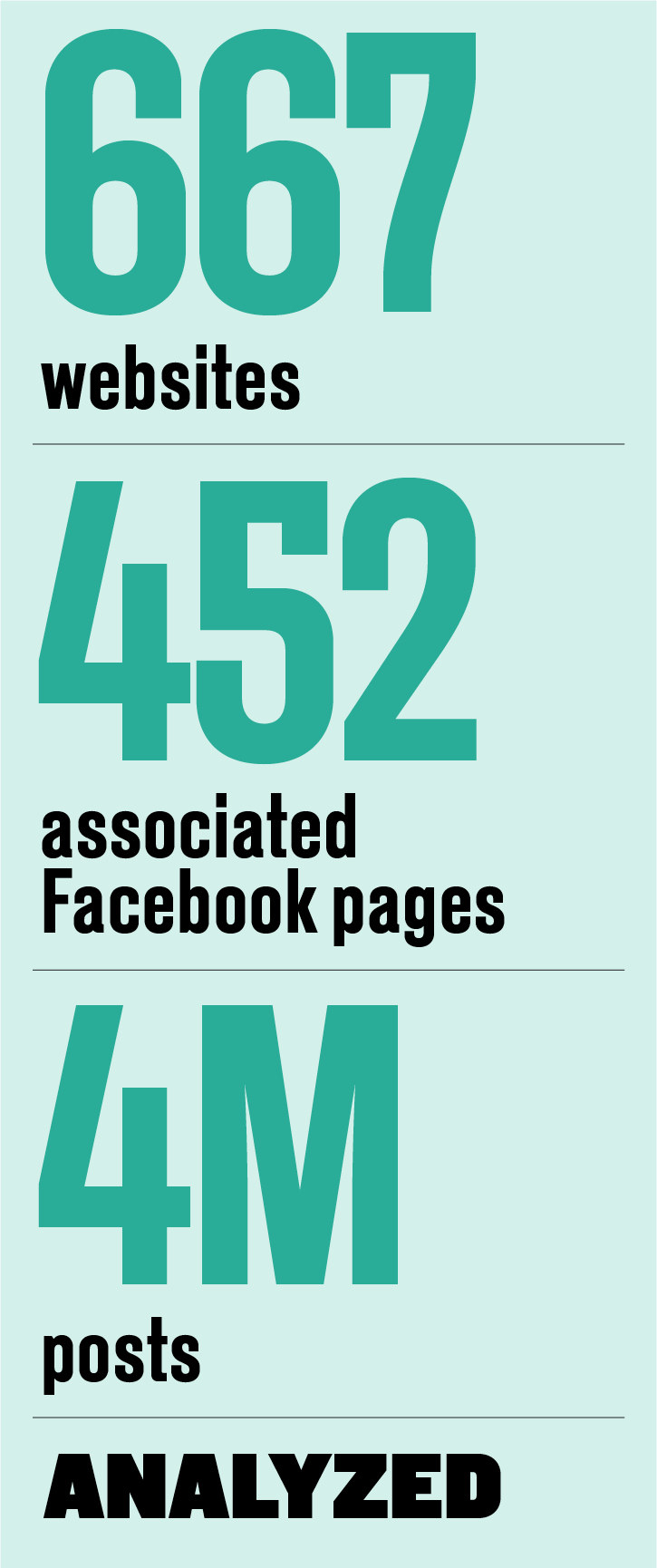
The extensive BuzzFeed News analysis shows just how deeply outrage and the revenue it generates are tied to divisive online discussions.
“Politics changes perspectives, but money really changes people’s perspectives, so I’d really rather not say anything about that,” said Freddy Hernandez, who operates conservative news website YesImRight.com and its associated Facebook page with more than 1.4 million fans.
Hernandez doesn’t list his name anywhere on the site, and he’s primarily known online for his YouTube videos about cars, as well as his occasional contributions to auto websites such as Jalopnik. Hernandez told BuzzFeed News he watched Occupy Democrats and other Facebook pages generate huge engagement and traffic and wanted to see if he could do it too.
Another man who ran and worked on several conservative Facebook pages and websites told BuzzFeed News he got into the game because of his beliefs. But soon the money became his driving force.
“I thought I was in it for the cause,” he said in an interview conducted over Facebook Messenger. “Six months later and after [I bought] an Infiniti G35 and Corvette, I realize it was probably more about the profit.” (He asked not to be named because he has exited the business.)

To fully understand and showcase the massive new world of online partisan news, BuzzFeed News spoke to more than a dozen liberal and conservative site owners and writers, obtained financial filings from the IRS, and created a database of 667 political news websites covering US politics on the left and the right.
BuzzFeed News gathered and analyzed the websites' domain name registration dates, who owns the websites, whether a website is connected to other sites on the list through a shared Google Analytics or AdSense code in its source code, and, when possible, whether the site appears to be run from a country other than the United States. We also examined linking patterns between sites and used data from Alexa to analyze the audiences. (Sites that have the same Analytics or AdSense code often share the same owner.)
This information was combined with Facebook data gathered from the 452 pages associated with the sites in the database. BuzzFeed News downloaded the more than 4 million posts and their associated number of shares, reactions, and comments published between Jan. 1, 2015, and March 31, 2017. (To read a detailed overview of how the data was collected and analyzed, see the bottom of this story. You can also access our full data set on GitHub here. If you believe a site has been mistakenly included or classified, or if you’ve identified a different kind of error, please contact us via this form.)
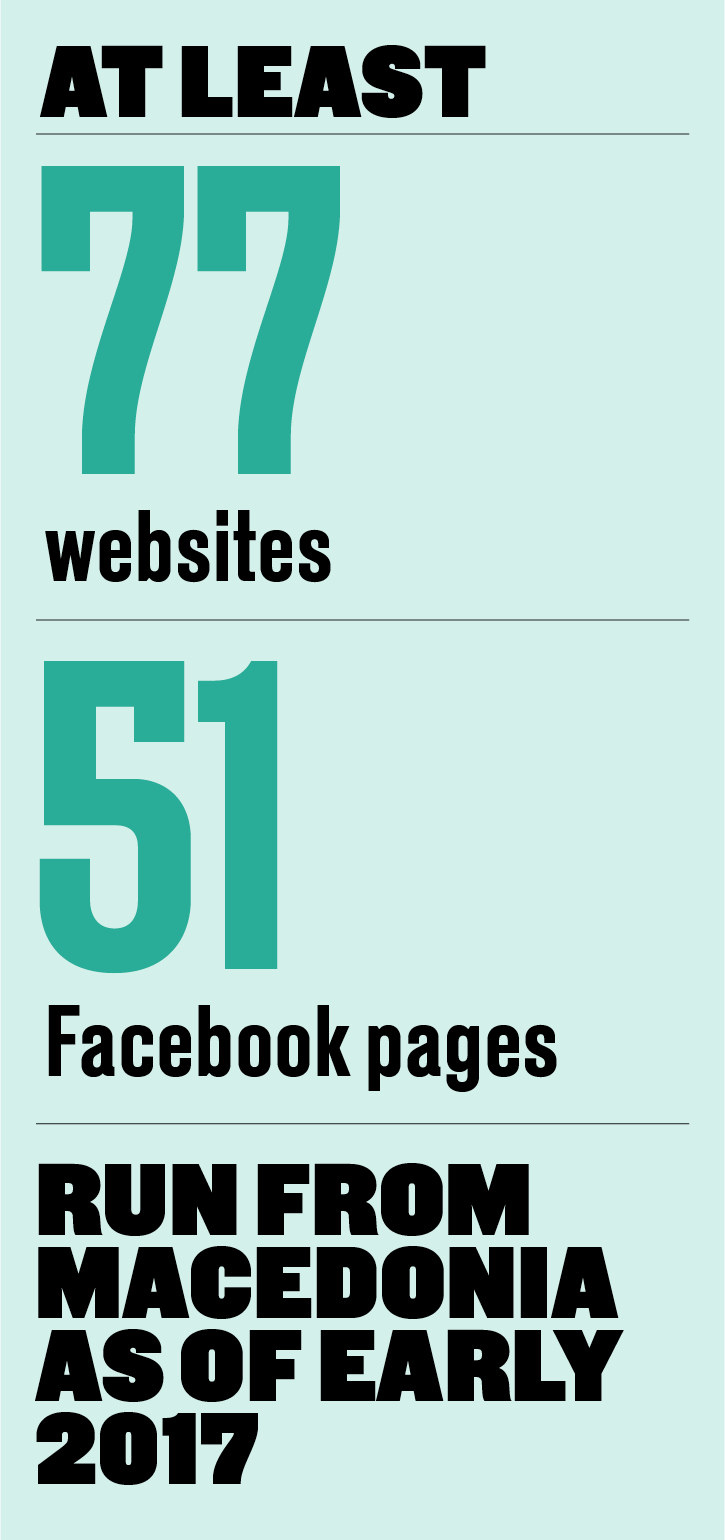
The interviews and data reveal a large, often interconnected world where Facebook plays kingmaker as much as it crushes dreams, where anger and stoking partisan hatred are core strategies on the right and left, and where the biggest players are working to secure dominance by partnering with, or acquiring, competitors and launching new sites to flood the market so new players can’t gain a foothold.
Other key findings:
- There are at least five people or companies that operate both liberal and conservative partisan news sites. These publishers work both sides of the aisle in order to capture as much revenue as possible, and to hedge against one side or the other dropping off in terms of growth.
- The election marked a high point in Facebook engagement for partisan pages on the left and the right, making it a catalytic event that caused at least 187 new partisan news sites to launch, and that saw partisan news’ influence over the online political conversation reach new heights.
- Of the 667 websites in the database, 490 are conservative and 177 are liberal. While this data set does not include all partisan news sites that cover American politics, its size and comprehensiveness suggests that the partisan conservative universe is bigger and more established than its counterpart on the left.
- The number of people running partisan conservative news sites outside the US is significant. The now-famous cluster of mostly pro-Trump sites run from Macedonia is the largest international group in the database, with at least 77 sites and 51 Facebook pages as of early 2017. However, as this research was in progress, Facebook shut down roughly three dozen US politics pages run by Macedonians, and some of the websites associated with them stopped publishing. The number of Macedonian-run sites and Facebook pages is constantly in flux as sites and pages are killed and new ones are launched.
- Writers for many of the newer partisan sites are compensated for their articles by a share of the advertising revenue earned from their stories. Editors for these sites are often paid $5 or $10 per post. Data obtained by BuzzFeed News, for example, shows a writer for the liberal Addicting Info group of sites earned $20,026.63 in one month for a single article back in 2014. But now some sites are beginning to move away from the ad-share payment model. More established partisan sites do not use the revenue-sharing model.
- Liberal and conservative partisan news websites exist as parallel universes. An analysis of major traffic referrers among partisan sites revealed tight networks of interlinking within each ideological sphere — but hardly any referring from liberal to conservative websites, and vice versa.
- Publishers are obsessed with Facebook’s algorithm changes and with avoiding getting caught up in the social network’s stepped-up initiative to reduce clickbait and misinformation in the News Feed. Conservative publishers complain that posts and sometimes even entire pages are removed without warning, while comparatively few liberal page owners report the same challenges. Deep suspicion of Facebook runs through the conservative partisan news world.

A New Breed of Partisan News
Partisan news has always been a part of the American media landscape. The earliest newspapers in the United States were closely linked to political parties or specific political stances. This remained the reality until well into the 20th century, when cities that once had multiple papers of divergent partisan alliances saw them consolidated often into just one or occasionally two papers, according to Mitchell Stephens, a journalism professor at New York University who discussed partisan media in a recent essay for Politico Magazine.
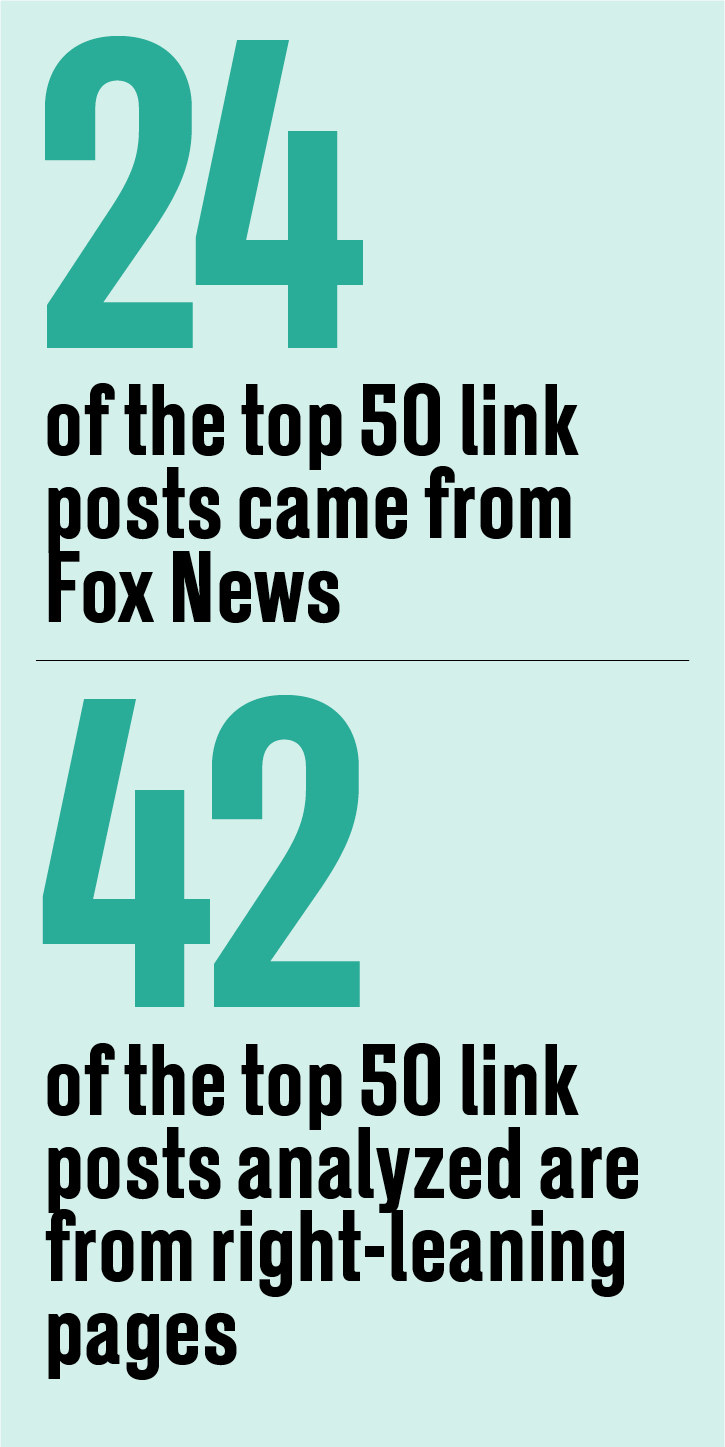
“Journalism in the United States was born partisan and remained, for much of its history, loud, boisterous and combative,” he wrote.
Over time, that tradition has continued and changed in established media outlets. There are a number of ideologically driven magazines on the left and right that feature both reporting and opinion, as well, like the Weekly Standard on the right, or Mother Jones on the left. There are cable networks that have taken ideological and, at times, essentially partisan stances, like MSNBC’s liberal programming and Fox News’ defense of President Trump. The early web of the late ’90s brought new digital outlets such as TownHall.com and AlterNet.org, which offered commentary from the respective political right and left. The rise of blogs in the early aughts added more players to the space, such as DailyKos.com and NewsBusters.org.
But it was the rise of Facebook as a news platform and the emergence of the Occupy Wall Street and tea party movements on the left and right that gave birth to a new breed of sites in recent years. These sites now operate many of the partisan Facebook pages generating the highest engagement compared to more established players, and they therefore attract some of the biggest audiences online.
In a feature last fall, the New York Times Magazine described these new sites and Facebook pages as “hyperpartisan,” and since then the label — which some publishers and writers for these sites find pejorative — began to take hold.
“Individually, these pages have meaningful audiences, but cumulatively, their audience is gigantic: tens of millions of people,” wrote John Herrman. “On Facebook, they rival the reach of their better-funded counterparts in the political media, whether corporate giants like CNN or the New York Times, or openly ideological web operations like Breitbart or Mic.”
Today, the new so-called hyperpartisan sites mix with long-standing outlets to create a new, huge online partisan news ecosystem that is taking over people’s timelines and creating alternate universes in which your side is always right and the other side is always wrong.
It’s important to be clear that partisan news is not the same as fake news, nor is it inherently of low quality. Outlets with clear ideological leanings often act as standard-bearers for policy ideas and important political debate. The 667 websites that make up the list used for this report represent a variety of viewpoints on the left and the right, and offer varying levels of quality. Some deliver Pulitzer Prize–worthy reporting, while others propagate fake news, or publish false headlines atop otherwise accurate stories. (A previous report by BuzzFeed News examined the accuracy of content shared on a sample of hyperpartisan liberal and conservative Facebook pages.)
Measured in Facebook engagement, website traffic, and the sheer number of outlets, partisan news is in the midst of a new golden age in the United States. It’s not a coincidence that this is occurring at a time when many mainstream media outlets are facing significant economic challenges, and when data from Pew and other organizations show that Americans themselves are also more partisan today than in recent decades.
“For the first time in surveys dating to 1992, majorities in both parties express not just unfavorable but very unfavorable views of the other party,” said a June 2016 report from Pew. “And today, sizable shares of both Democrats and Republicans say the other party stirs feelings of not just frustration, but fear and anger.”
These newer partisan sites and pages, which are the main focus of this report, feed partisan fear and anger and richly reward that partisan fear and anger in the form of Facebook engagement and ad revenue.
This is a look at the biggest players in the world of liberal and conservative online news, who they are, how they’re dominating on Facebook, and what happens when partisan news suddenly becomes a massive online moneymaker.

Liberal Facebook Pages Dominate Top-Performing Posts
Facebook is now the internet’s biggest referrer of traffic to English-language news websites, and newer partisan publishers say it’s also their primary traffic source. BuzzFeed News gathered engagement data — the total number of shares, comments, and reactions (likes, loves, wows, hahas, sads, and angrys) — for all posts published between Jan. 1, 2015, and March 31, 2017, on the more than 400 Facebook pages associated with the websites for which BuzzFeed News was able to obtain data. We also gathered the total number of fans for each page as of July 21, 2017.
These are the 20 most popular left-leaning and right-leaning Facebook pages, as measured by total “fans”:
Top 20 left- and right-leaning Facebook pages by total number of fans (in millions)
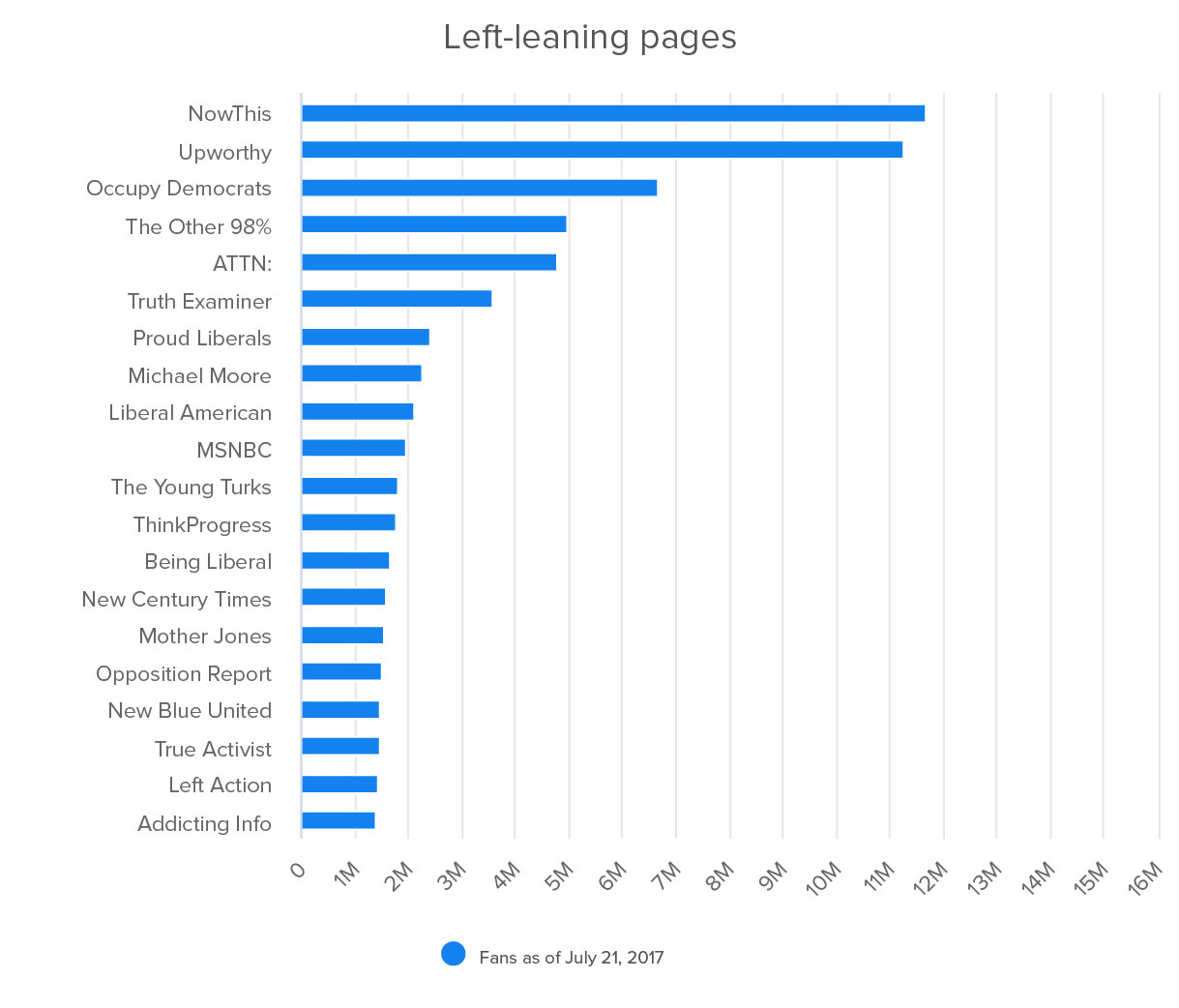
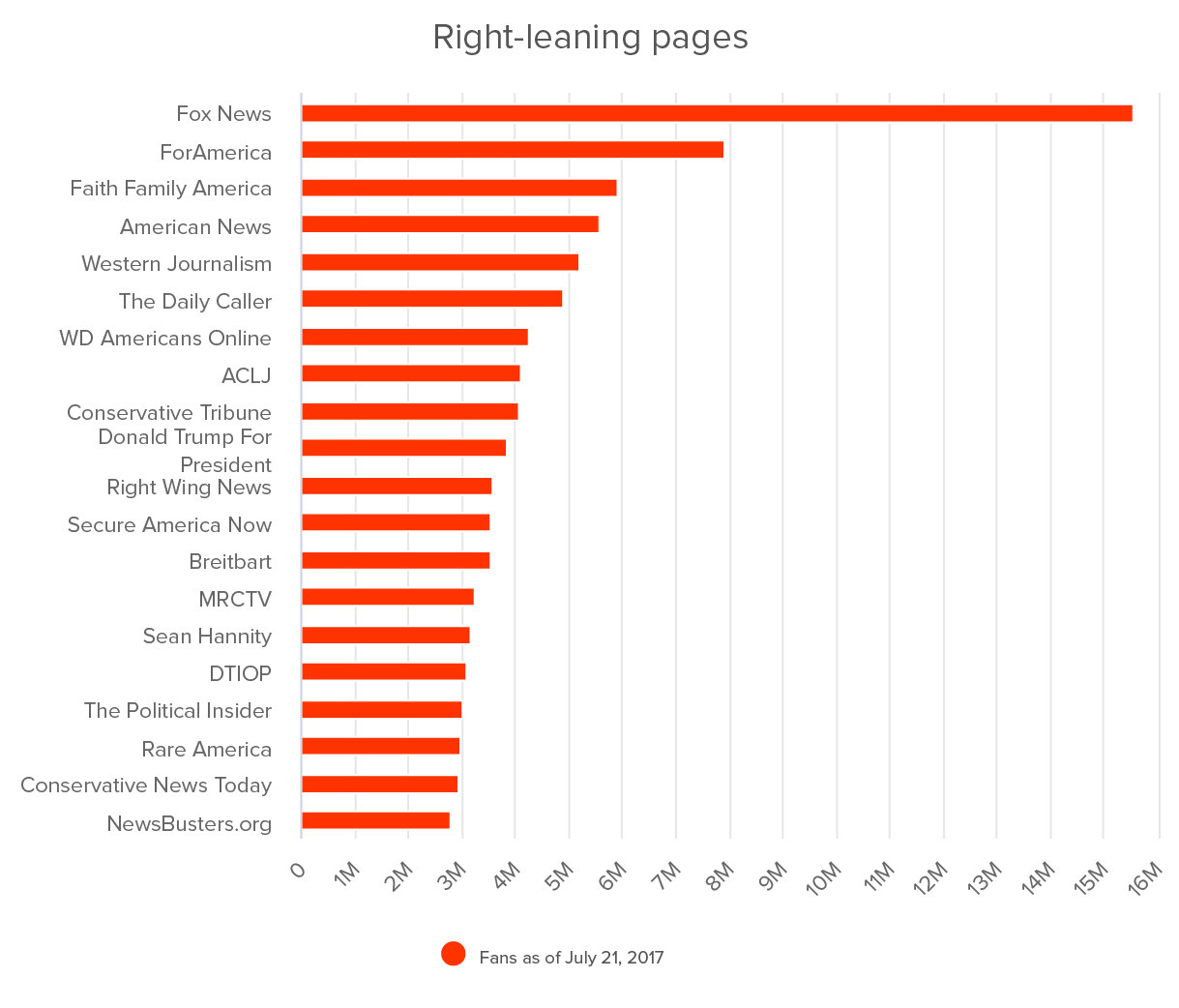
The top pages on each side represent established outlets (Fox News, Mother Jones) as well as a large number of newer players who fall into the hyperpartisan category. In fact, both the left-leaning and right-leaning top 20 lists are largely composed of these newer outlets, such as Truth Examiner, Occupy Democrats, and Proud Liberals on the left, and Breitbart, American News, and Conservative Tribune on the right.
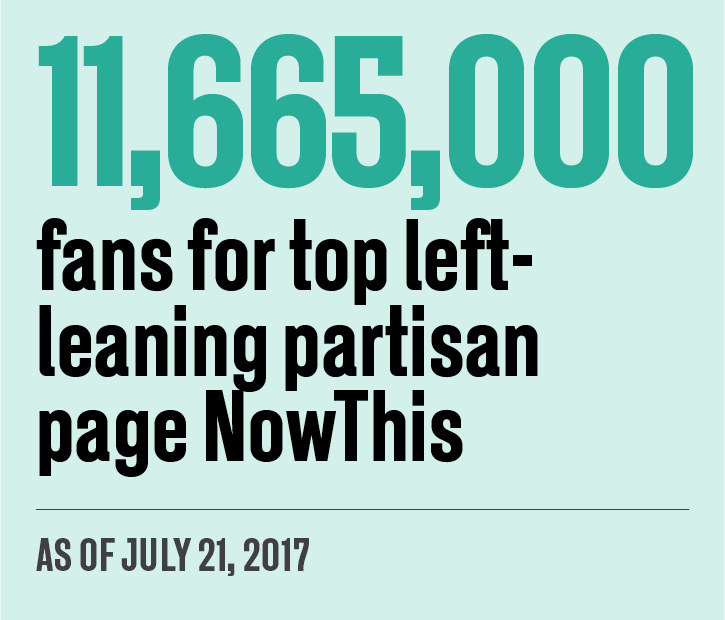
The top 20 conservative pages calculated by the number of fans are bigger than their liberal counterparts, which means they have larger potential reach on Facebook. However, an analysis of the 50 posts by total engagement across all pages found that liberal pages scored more top viral hits. Left-leaning pages accounted for 33 of the top 50 posts.
This helps reinforce a key difference between the liberal and conservative partisan Facebook page universes: There are far more conservative pages and those pages have more total fans, but the liberal side is dominated by a small number of powerful pages that generate an outsize number of Facebook engagements.

Left-leaning pages NowThis News and Occupy Democrats together accounted for half of all posts in the top 50. NowThis was responsible for 15 top-performing posts and Occupy Democrats had 10. Only two of their 25 top-performing posts were photos, which reinforces that videos go viral more than photos or links. Videos accounted for 32 of the 50 top-performing posts on these pages. This is likely due at least in part to Facebook’s emphasis on video content in the News Feed.
Occupy Democrats also stands out on the list of the 50 top-performing posts because four of its anti-Trump videos made the list. (There was also one viral video of anti-Trump protests made by NowThis.)
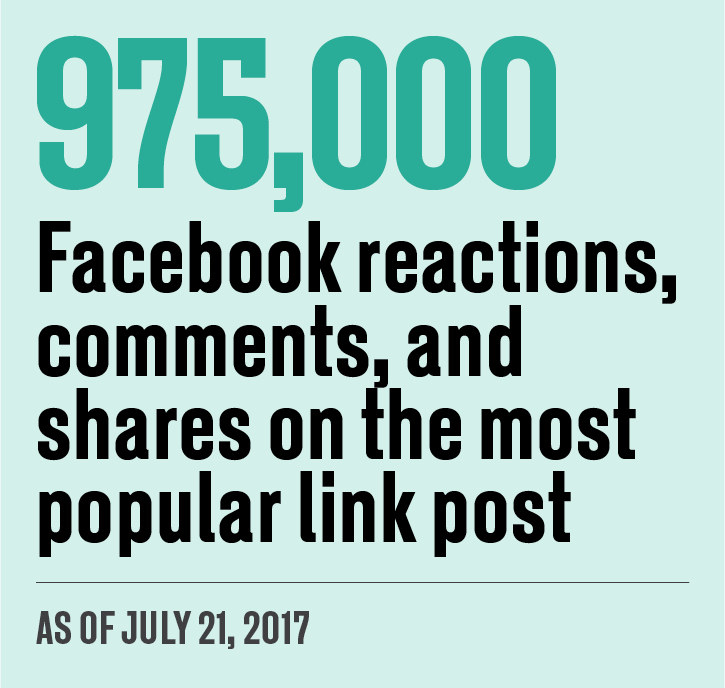
In contrast, not a single piece of pro-Trump content cracked the top 50. This suggests that Trump’s victory has been good for growth and engagement on liberal websites and Facebook pages, but not as useful for the conservative side. Liberal pages now have a clear, powerful enemy to attack day after day in the same way conservative publishers targeted Barack Obama for years. (An anti-Obama video from Allen West’s conservative Facebook page had the third-most engagements of all posts reviewed by BuzzFeed News. It was published back in 2015.)
It’s also worth noting that several of the top-performing posts from pages on both sides were not overtly political. These included heartwarming videos of kids showing good sportsmanship, of a football team making a moving gesture for a cheerleader fighting cancer, as well as a meme calling for prayers for America, and a video starring a kitten who thinks she’s a puppy.

Top-Performing News Stories

While videos and photos rule the top-performing content for partisan Facebook pages, links to news articles still generate significant engagement. And when it comes to links, conservative pages dominate. Fox News is the king of top-performing link posts among the pages analyzed — it accounted for 24 of the top 50 link posts.
In total, 42 of the top 50 link posts analyzed were from conservative pages. Upworthy is the only left-leaning page that had more than one post on the list of 50 top-performing links on Facebook. It earned two, the same number as Hannity.com, a conservative site associated with Fox News host Sean Hannity.
American News, another conservative page, had eight top-performing link posts, the second most hits behind Fox News. American News also stands out for another reason: It had one story on the list with a false headline.
The story, which was published after Trump's victory, was “Miley Cyrus to Leave America for Good After Challenging Donald Trump and Losing Big Time.” Cyrus had earlier made a comment about possibly leaving the US if Trump won, but she had not said anything new about actually leaving. (BuzzFeed News previously revealed that American News is one of the five companies or people who operate both conservative and liberal websites. More on that below.)
Another page with a top 50 link of note is American Action News. A recent BuzzFeed News story revealed it’s connected to a DC lawyer, Dan Backer, who ran one of the biggest pro-Trump PACs during the election. That site has been used to raise money for PACs linked to Backer, though that relationship is not disclosed on the site and almost none of the calls for PAC donations were labeled as ads. Its big hit was for a story headlined “Support Donald Trump 2016.” The post consisted entirely of an image, which no longer loads on the page.
Also present on the top 50 links list is ConservativeFighters.com, a website run by a 20-year-old Macedonian man. It scored a hit with a story about Barron Trump. The Facebook page associated with that site is the top-performing Macedonia-owned page among those analyzed by BuzzFeed News — and it consistently beats out many of its American counterparts.
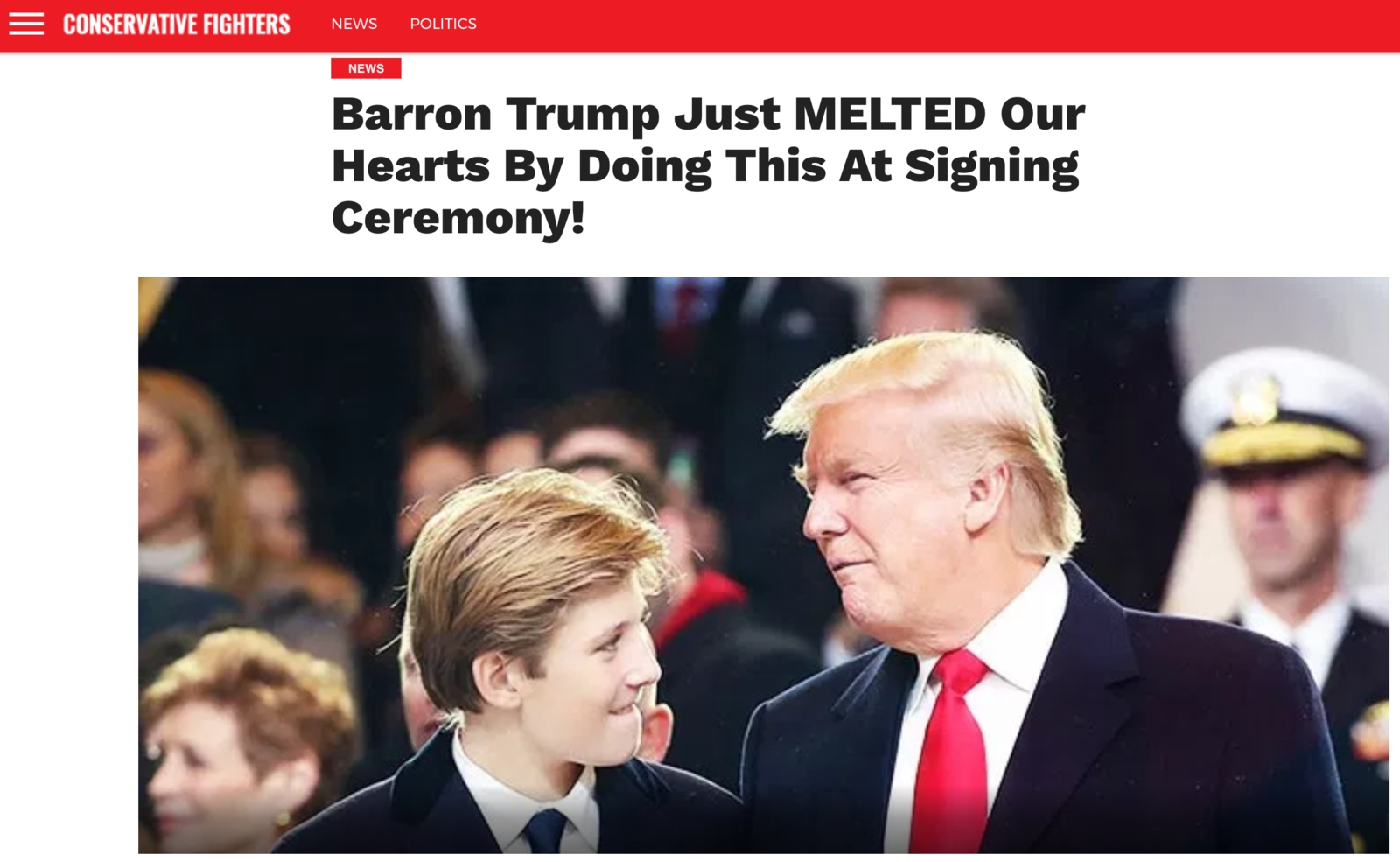
Perhaps the most surprising link on the list of top-performing stories is from Jacobin, a socialist website. In November 2015 it shared a link to its subscription page, and the share line was a favorable quote from Noam Chomsky about the publication. The Facebook post managed to generate over 360,000 Facebook engagements, even though a magazine subscription page seems an unlikely candidate for a viral post.
One possible explanation, which also serves as a caveat for the top posts' data, is that Jacobin may have paid to promote the post as an ad on Facebook. It’s possible that other posts on the top 50 lists generated from the data also benefited from paid boosting on Facebook, including, for example, the American Action News story.

Fox News vs. Occupy Democrats
One way to appreciate the battle between the right and left on Facebook, and their differences, is to look at the most-engaged pages for each side. BuzzFeed News examined the total number of weekly Facebook engagements — shares, comments, and reactions — for pages since the beginning of 2015 and found that Occupy Democrats on the left and Fox News on the right are the top pages in each political category. They have been locked in a battle for Facebook dominance since mid-2015:
Total weekly engagement for Facebook pages of Fox News vs. Occupy Democrats (in millions)
Source: Facebook
Note: Total engagements include all shares, comments, and reactions (reactions include likes, loves, wows, hahas, sads, and angrys).
Though they’re often neck and neck in total engagement, the pages use very different strategies to succeed. Occupy Democrats uses a heavy mix of video and memes to generate viral engagement. Even though it has fewer than half as many Facebook fans as Fox News, it often manages to generate the same or more engagement thanks to a strategy that plays to the News Feed algorithm’s preference for a mix of native images and video.
Fox News eschews memes and less than one-fifth page's posts are images. The network’s video tends to be clips from live events or from its shows. Its page posts far more links. As previously noted, its links generate significantly more engagement on Facebook than that of just about all of its competitors on the right and left.
These two pages also consistently generate more total engagement than the pages of major media outlets. BuzzFeed News used the CrowdTangle Intelligence tool, which is owned by Facebook, to compare the total engagement for Occupy Democrats and Fox News to CNN, the New York Times, and the Washington Post. The pages with more partisan content (shown in blue and green) consistently beat their mainstream rivals in terms of total engagement from Jan. 1, 2016, until the end of June this year:
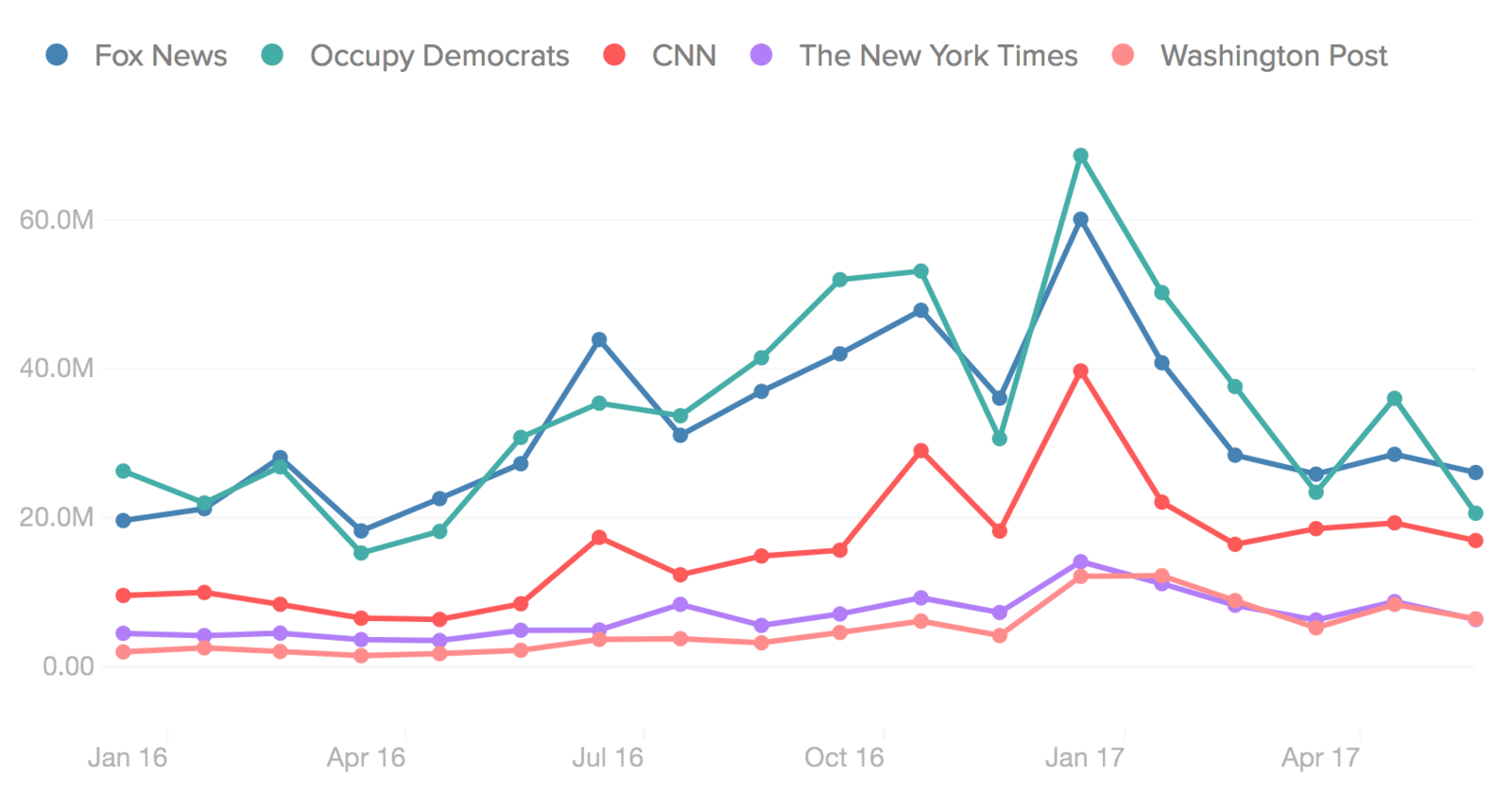
The mainstream page with the closest engagement is CNN. But it’s still outperformed by Fox News and Occupy Democrats in spite of the fact that CNN’s page currently has almost 28 million fans compared to 6.8 million for Occupy Democrats and 15.5 million for Fox News.
CrowdTangle also calculated the average “interaction rate” for a page. In this, too, Occupy Democrats and Fox News outpace the mainstream pages:

The interaction rate is "the average number of interactions per post, divided by the size of the account,” according to CrowdTangle.
One thing Fox News and Occupy Democrats have in common is they were both founded by people with strong ties to their respective political parties and ideologies. Roger Ailes, who created Fox News and led it until last year, was a longtime Republican strategist and kingmaker.
Occupy Democrats is run by twin brothers Omar and Rafael Rivero. Omar ran as a Democratic candidate for the Florida House of Representatives in 2014, and Rafael has been an outspoken advocate for raising the minimum wage, among other causes. They view their Facebook page as a crucial front in the battle between Republicans and Democrats.
“We want to give people the ammunition to engage in meme warfare, giving people the fodder to win the battles and ultimately the war,” Rafael said in 2016. “The battles are fought and won or lost on social media.”

Trump Delivers a “Bonanza of Growth” for Liberal Pages
For all of 2015, right-leaning Facebook pages had the edge on their liberal counterparts in terms of total engagement per week. But as 2016 arrived and the presidential cycle heated up, liberal pages began to gain ground and often generated more total engagement per week.
BuzzFeed News examined the total Facebook engagements for the 100 top-performing posts on the left and right each week between Jan. 1, 2015, and March 31, 2017. The data revealed that overall, both sides saw huge increases in engagement in the three months before the election, and at many points since Trump’s win. But it’s also clear that in the five months since Trump’s victory, the top liberal pages consistently generated more engagements per week than the top conservative pages.
Total weekly engagement for the top 100 posts for left- and right-leaning Facebook pages (in millions)
Source: Facebook
Note: Total engagements include all shares, comments, and reactions (reactions include likes, loves, wows, hahas, sads, and angrys).
Prior to the election, 2016 saw the two sides neck and neck, with each experiencing occasional spikes that put them on top. But beginning the week of Nov. 20, these liberal pages consistently generated more total engagement until the week of March 26, the last week for which we gathered Facebook data.
“I think liberal pages are definitely seeing a bonanza of growth under Trump,” said Patrick Brown, the CEO of Liftable Media, which publishes several conservative news websites. “I'm not surprised by that at all.”
While liberal pages and websites are experiencing growth, some conservative players are facing challenges. They complain about what they see as censorship by Facebook, and some have had to scale back. Heat Street, a well-financed, right-leaning website launched by Rupert Murdoch’s Dow Jones, recently announced it will cease to exist as a stand-alone site and will be folded into MarketWatch.
“In a way, we were hoping that Clinton would win,” one former staffer told Salon.com. “Not because we agreed with her but because it would have been so much easier for us if she had. We could have gone back to bashing the Democrats.” (Another challenge for Heat Street was that one of its creators, Louise Mensch, left the site and has since transformed herself into a fervent anti-Trump Twitter crusader who often accuses people of being Russian agents with no evidence to back it up.)
To get a sample of the year-over-year growth of liberal and conservative pages, BuzzFeed News collected the total Facebook engagements earned in March 2016 for the top 20 pages we identified on the right and left by fan counts. We then gathered the total engagements for March 2017 for those same pages. (Caveat: It's possible some pages have deleted certain posts retroactively; those posts would not be accounted for in the data below.)
The two graphics below show the total engagement for posts published in March 2017, compared to a year earlier:
Total monthly engagement of left- and right-leaning Facebook pages for March 2016 and March 2017 (in millions)
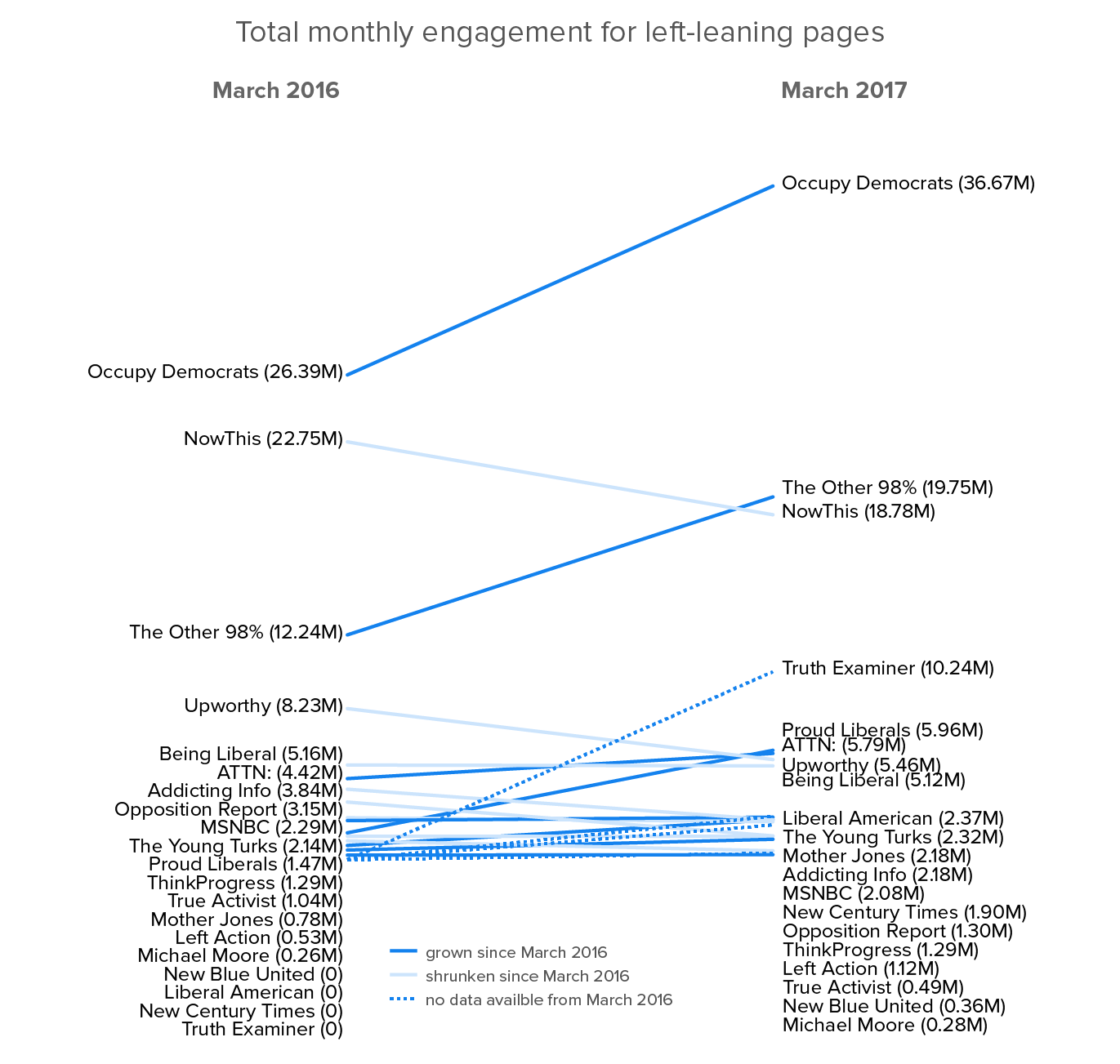
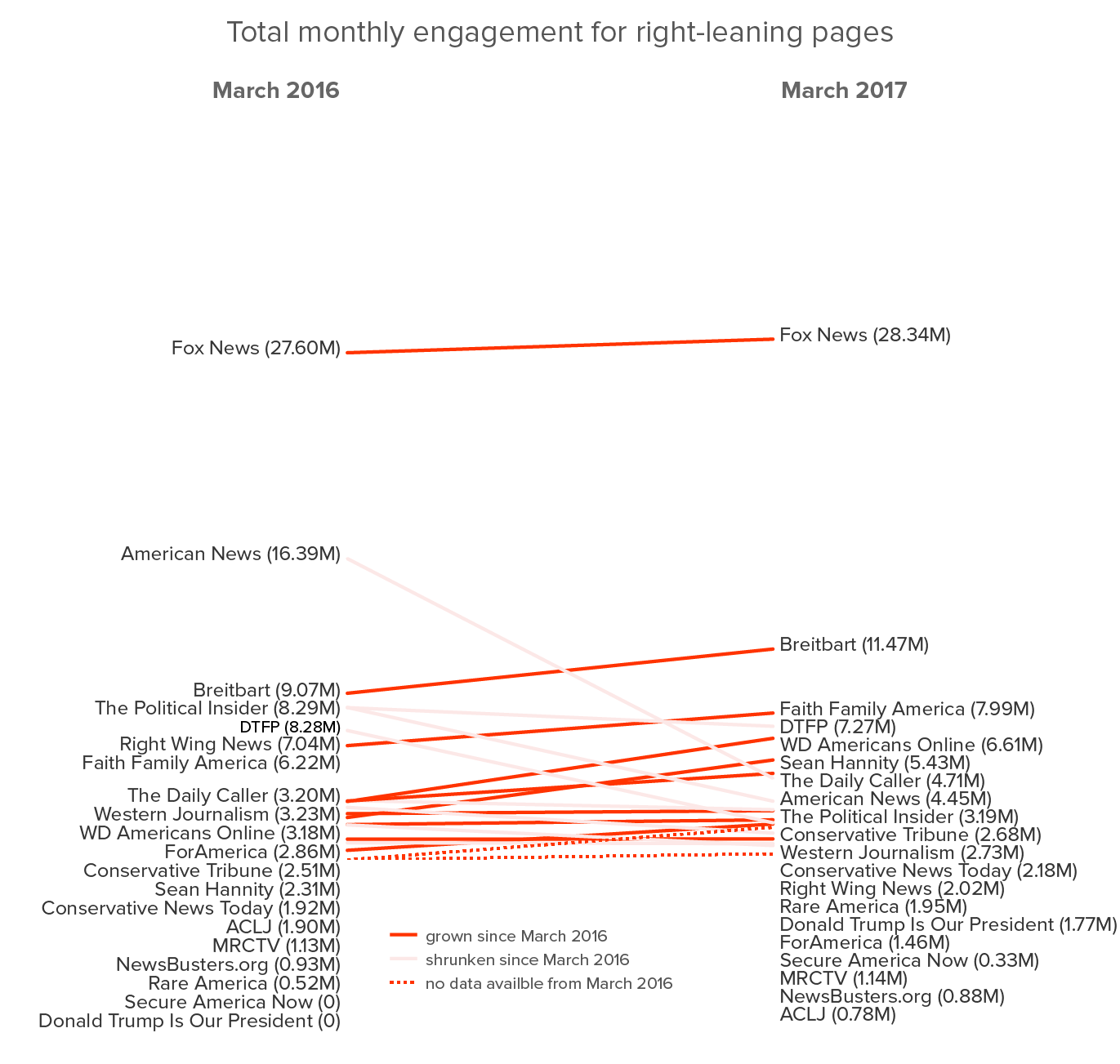
Occupy Democrats achieved significant growth year over year, as did fellow liberal page The Other 98%. But just as noteworthy is that a liberal page that appears not to have existed in March 2016 — Truth Examiner — was able to generate over 10 million Facebook engagements for its posts that month.
On the conservative side, Fox News and other large pages saw growth year over year. As with Truth Examiner, there is at least one conservative Facebook page that apparently didn’t exist last March and is now generating massive engagement. Conservative Media today has more than 2.4 million fans and saw just under 11 million total engagements this past March. As previously noted, it’s run by a 20-year-old man in Macedonia who launched it when he was a teenager.
One big conservative player, the aforementioned American News, experienced a massive drop in engagement. Last March it had over 16.3 million total engagements. A year later it was down to 4.4 million engagements. During that time, the page added 400,000 new likes, which should have helped help it grow engagement over time. Yet the page’s engagements shrank year over year.
Further research using CrowdTangle Intelligence shows that the page’s engagements fell off a cliff since the election (the dark blue color represents engagements for link posts, while green is for photos, and purple is for video):
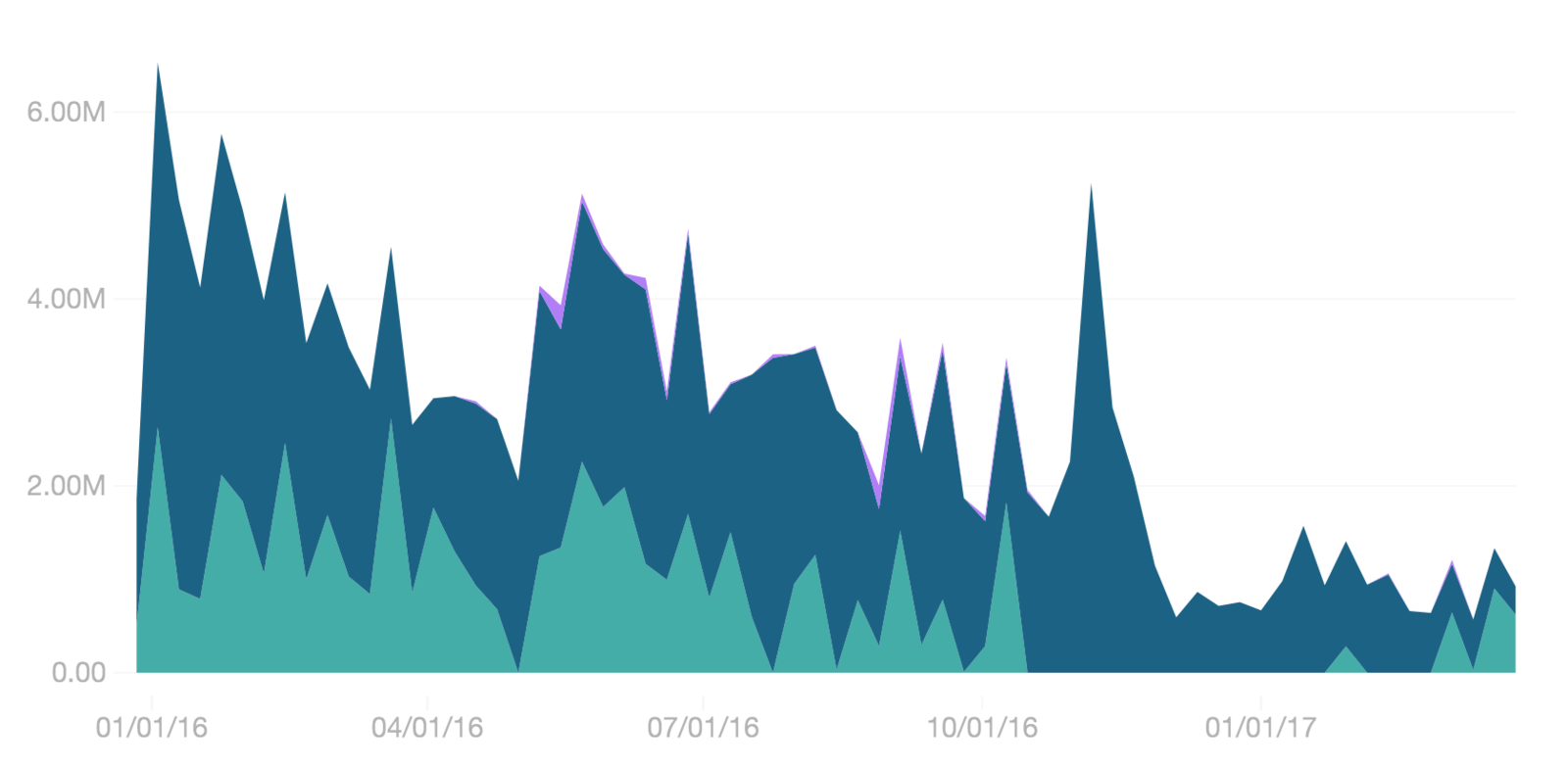
Big liberal pages such as Upworthy and NowThis had lower engagements in March 2017 compared to year earlier, but data from CrowdTangle Intelligence shows their drop had not been as significant as American News’:
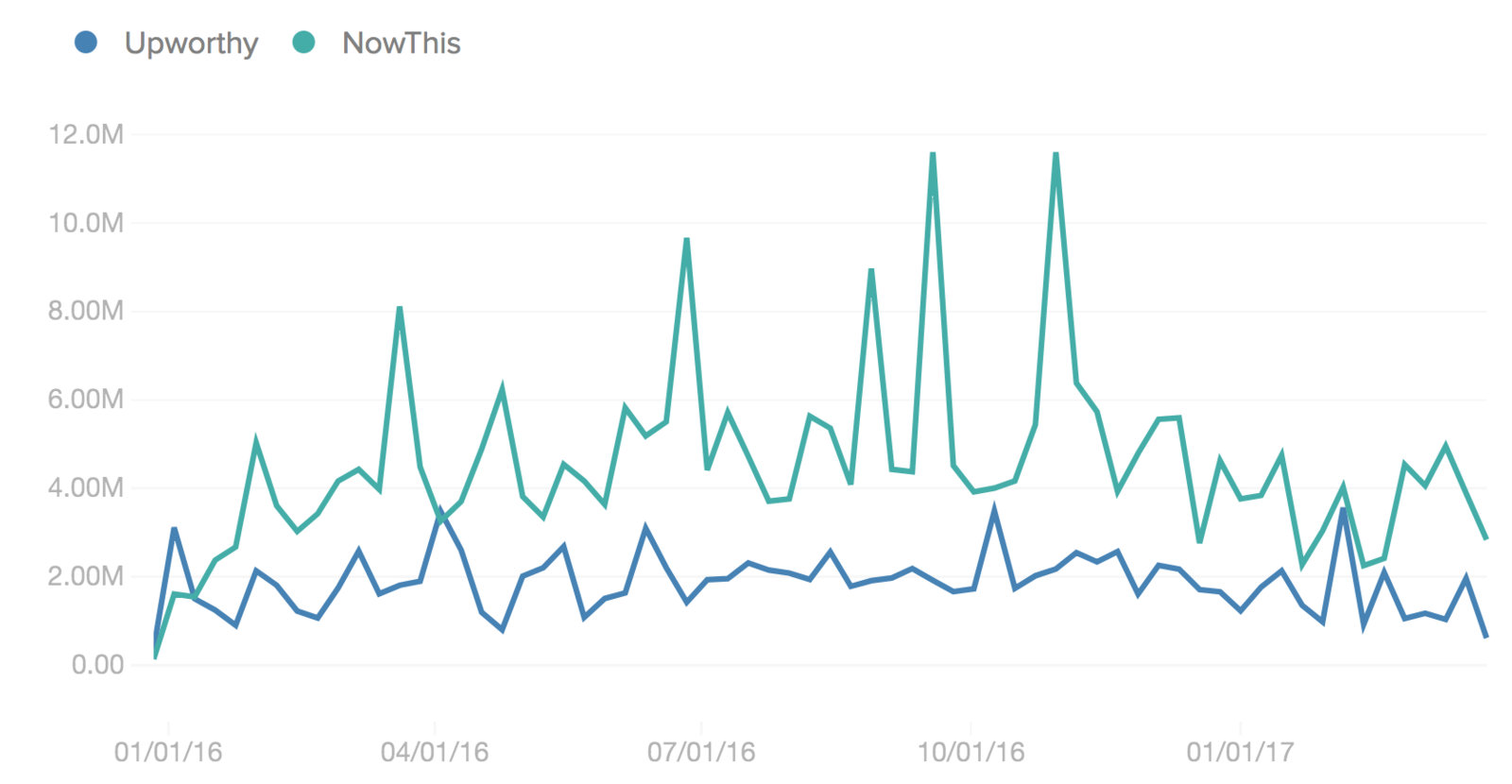
American News is just one page, but several conservative publishers who spoke to BuzzFeed News, and who didn’t want their names used for fear of repercussions from Facebook, said they have struggled to generate growth since the election. Along with not having a powerful enemy such as Hillary Clinton or Barack Obama to target, they also believe their pages are suffering from Facebook’s efforts to crack down on clickbait and what the company calls “false news.” One publisher told BuzzFeed News he exited the industry because his pages kept being removed by Facebook for terms-of-service violations.
“We got sick and tired waking up every day [wondering] about what stupid violation Facebook would have against a page,” he said.
Another publisher said his page, which has millions of fans, experienced reduced reach until he removed a specific type of ad from his site. (Facebook had recently announced it would punish websites that were littered with junky ads.)
“We got sick and tired waking up every day [wondering] about what stupid violation Facebook would have against a page.”
He and the publisher who exited the business, as well as a conservative publisher who previously spoke to BuzzFeed News, said they believe Facebook’s content moderators treat conservative pages and content differently.
“I think people in all areas are having issues, but I do believe Facebook moderation is more biased against conservatives,” he said.
In a previous statement about content removals, a Facebook spokesperson told BuzzFeed News that ideology is not a factor in content moderation. “Facebook is a platform for all ideas,” said the spokesperson, who spoke on the condition that they not be named. “Our mission, and business, relies on giving people of all different voices and opinions a place to share.”
The company recently announced it is hiring an additional 3,000 people to help moderate content.

Liberal and Conservative Sites Live In Parallel Universes
Researchers at King’s College and University College London in England used data from Alexa, a website analytics platform, to to analyze the “upstream” site data for partisan sites identified by BuzzFeed News. Upstream websites are ones that Alexa found are commonly visited by users before browsing to a partisan website — which means upstream sites act as key drivers of traffic to partisan websites. Common upstream sites include Facebook and Google, since search and social links are major ways in which content is discovered on the web.
The 483 partisan websites for which Alexa had upstream data showed a clear pattern of partisan sites receiving traffic from other partisan sites.
“Some of the partisan websites also appear as upstream sites, implying that users are led from one website to another within the family of partisan sites,” said Shweta Bhatt, a graduate student in intelligent systems at King’s College London.
Bhatt and her colleagues found that 38% of the 483 partisan sites had at least one other partisan website among their top five upstream sites. It was also clear that these partisan upstream sites are almost exclusively other sites with the same ideology:

This suggests that conservative sites rarely link to liberal sites, and vice versa. The researchers also analyzed the upstream sites for the top 500 news websites ranked by Alexa to compare their level of interlinking to that of the partisan sites. They found that 23% of the the top 500 news sites had at least one other top news website among their top five upstream sites, compared to 38% for the partisan sites.

Big Players Running Multiple Websites And Pages
Patrick Brown is building one of the biggest online conservative news companies, but he doesn’t like the term “conservative news.”
“We produce all kinds of news and entertainment. What you call pejoratively ‘conservative news’ I would call opinion and commentary,” he said in an email interview with BuzzFeed News.
Brown added, “We also push back against the word ‘partisan’ as there are plenty of issues with both parties and our audience definitely reflects that."
His company, Liftable Media, operates two large political news websites: ConservativeTribune.com, which has more than 4 million fans on Facebook, and WesternJournalism.com, which has more than 5 million fans. Both pages are among the 10 largest conservative pages in the BuzzFeed News database. Liftable is the only company to own more than one Facebook page in the conservative top 10, according to BuzzFeed News’ research.
Liftable also operates TheWildcard.com, a sports website, and Liftable.com, which publishes uplifting viral content. Brown’s father, Floyd Brown, a part owner of the company, is a longtime conservative activist and author who is famous for creating the “Willie Horton” ad that helped sink Michael Dukakis’s presidential campaign.
To bolster his operation, Brown recently acquired many of the assets of Liberty Alliance, a company that operated several conservative websites, and that also managed an ad network that represents several large conservative sites. Brown’s Arizona-based company subsequently acquired an e-commerce site called PatriotDepot.com that sells “Supplies for the Conservative Revolution.” It offers American-made flags, Bibles, and “Hillary for Prison” T-shirts, among other items.
With the addition of the new assets, Brown’s operation now boasts perhaps the most total Facebook fans of any new conservative news company, not to mention a large email list.
“Many people are disgusted with what they see coming out of these supposedly unbiased sources and they are actively looking for an alternative.”
“We see our competitors as the formerly mainstream media that has drifted more and more to the left, both politically and culturally, in the last 40 years or so,” he said. “That shift has accelerated in the last few years. Many people are disgusted with what they see coming out of these supposedly unbiased sources and they are actively looking for an alternative.”
Brown said his content appeals to what he calls “Heartland America.”
“Our goal is to produce content that appeals to and reflects the interests of the people we call Heartland America with a quality level that meets or exceeds the quality of content produced by mainstream media,” he said.
Aside from Brown, there are many other players in the partisan news space who operate multiple properties. Over the past year in particular, many publishers have launched additional properties and new Facebook pages to try and expand their reach and ad inventory. This also helps make it harder for new players lured by the possibility of fast money to gain a foothold.
For example, the twin brothers behind Occupy Democrats recently launched a new liberal site, WashingtonJournal.com.
Another big player in the liberal partisan news world is the duo behind Addicting Info, Matthew Hanson and Daniel Gouldman. As previously reported by BuzzFeed News, Hanson got started years ago by creating partisan Facebook pages with names such as “Republicans Are Idiots and Arguing With Them Is a Waste of Time!” and “Help Ben Gleck Get More Fans Than Glenn Beck.”
Domain records and Google AdSense and Analytics IDs strongly suggest that the owners of Addicting Info also operate liberal websites OppositionReport.com, WinningDemocrats.com, IfYouOnlyNews.com, NewCenturyTimes.com, ReverbPress.com, BlueTribune.com, and News.GroopSpeak.com. Put together, they appear to operate the largest number of liberal partisan websites and Facebook pages.
Addicting Info has also operated as something of a training ground for many current liberal site and page owners. People who began working there as writers and editors eventually went on to launch their own sites and/or pages. BuzzFeed News also previously reported on the various legal disputes involving Hanson and Gouldman that have arisen from their operation of liberal websites and Facebook pages, and their interactions with partners and former employees. Former employees say they are extremely litigious. Hanson and Gouldman did not reply to questions sent by BuzzFeed News about the sites the own.
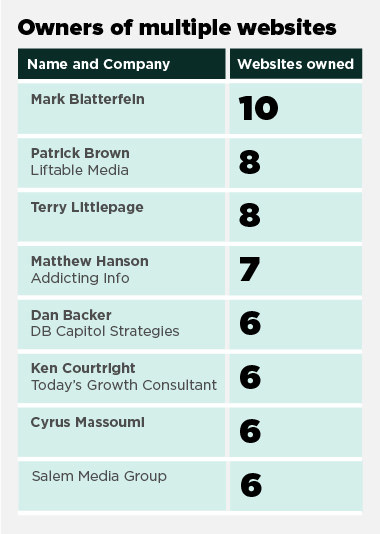
Given the larger number of conservative sites in the database, it’s not a surprise that BuzzFeed News found more people and companies who are running networks of conservative sites. One big player is Salem Media, a company that operates radio stations as well as a group of established conservative websites, including HotAir.com, TownHall.com, and RedState.com.
The owners of Liberty Alliance, the company acquired by Patrick Brown’s Liftable Media, now operate Klicked Media. Jared Vallorani and his brother, Brandon, built Liberty Alliance into a formidable ad network for conservative news websites. They sold their owned and operated properties to Brown and continue to operate the ad network under the name Patriot Ads.
The media kit for Patriot Ads says the sites it represents attract over 14 million unique visitors per month and the associated Facebook pages have 6.3 million fans. Jared Vallorani, the CEO of Patriot Ads, confirmed to BuzzFeed News by email that they represent at least 37 conservative websites, including ClashDaily.com, FreedomDaily.com, and EagleRising.com.
It was more common in the BuzzFeed News database to see networks of sites connected to newer operators who better fit the hyperpartisan, Facebook-driven model of news. But they too are seeing increased traction in this Trump era of intense partisanship. Mother Jones has seen a jump in subscribers, and it recently ran a successful campaign to crowdfund reporting on connections between Trump and Russia. The Weekly Standard, a conservative magazine founded in 1995, is staffing up with more hires this year.
But along with more established players, there are newer operators who have attracted scrutiny for their actions.
A previous BuzzFeed News story linked a network of six conservative websites — including AmericanActionNews.com, AmericanUpdate.com, and TrumpTrainNews.com — to Dan Backer, the DC lawyer who was one of the key people behind the biggest pro-Trump PAC in the 2016 cycle, and who has been accused of running “scam PACs.”
In an interview, Backer said he previously owned AmericanActionNews.com but sold it in 2014. He declined to name the new owner and did not directly answer questions about why that and other websites linked to him were being used to raise money and/or promote PACs he is involved with.
Two partisan publishers have been accused of using automated, non-human traffic to generate revenue.
Another network of sites is operated by Mark Blatterfein of Florida, who owns a mixture of conservative sites and some that verge into conspiracy territory. His websites include AltDrudge.com, TopSecretLeaks.com, ToTheDeathMedia.com, ViralLiberty.com, ViralPatriot.com, ExposingTyranny.com, BehindTheTyranny.com, DeathB4Disinfo.com, SecretsOfTheFed.com, and TheSearchForAliens.com. He also owns many unused political domains. One that stands out is HitleryCunton.com.

Blatterfein operates large Facebook pages with names such as Donald Trump Is Our President (3 million fans as of July 2017, and the 16th-largest conservative page identified by BuzzFeed News), Hillary for Prison (1.3 million fans) We Know The Secrets of The Federal Reserve (776,000 fans), and Viral Patriot (339,000 fans). (We Know The Secrets of The Federal Reserve was one of the Facebook pages that we were unable to gather data for in our July 21 pull of the Facebook API.)
Blatterfein did not respond to interview requests from BuzzFeed News — or to questions related to a recent post by a group of Russian researchers who investigate digital advertising and publishing and publish their findings at SadBotTrue.com. Their post accused him of using automated traffic to earn advertising revenue. SadBotTrue.com alleged that Blatterfein’s sites use traffic designed to make it appear as if large numbers of people are visiting his sites. This automated traffic would be loading webpages covered with ads, thereby generating revenue, according to SadBotTrue.com.
Another partisan publisher, Terry Littlepage — who operates RedRockTribune.com, WesternSentinel.com, DailyInsiderNews.com, DailyPresser.com, and PatriotCrier.com, among other sites — is facing similar accusations from SadBotTrue.com. Their report notes that he and Blatterfein are connected on Facebook and that some of their sites are hosted on the same server. Along with the SadBotTrue report, there are also articles and videos online that accuse Littlepage of plagiarizing the content for his websites.
Littlepage and Blatterfein did not respond to questions from BuzzFeed News, but Littlepage was cited by John Herrman in his New York Times Magazine story last year about hyperpartisan Facebook pages. Hermann reported that Littlepage runs roughly “50 politically themed Facebook pages” and that “in a good month, Littlepage’s properties bring in $60,000.”
Before he locked down his Facebook page, Blatterfein posted photos of a large new house his family is building in Florida.

A 2016 Surge in Partisan Domain Registrations
Publishers who spoke to BuzzFeed News say that the opportunity to earn significant revenue from political news sites resulted in an onslaught of new entrants into the market beginning in 2015 and particularly in 2016. That perception is backed up by an analysis of domain registration data for the more than 650 websites in the BuzzFeed News database.
BuzzFeed News used DomainTools to identify the date when each website domain name was registered. This data provides a sense of when these sites were first conceived of, though not necessarily the exact month or year of their launch.
Of the 667 websites in the data set, 55 were registered in 2015. More than a quarter of the domains — 187 — were registered 2016, making it by far the most active year in the data set.
The pace of increased site registrations continued into 2017: Fifty-two sites in the database were registered in the first six months 2017. (In spite of the traction left-leaning web properties are seeing this year, only six of these new sites are liberal.)
Taken together, 44% of the domains in the database were registered since 2015. The recent surge in registrations can be seen clearly in this chart:
Total monthly domain registrations for left- and right-leaning websites (1994 to 2017)
Source: DomainTools
The month with the largest number of new domain registrations in the data set is July 2016, when 21 right-leaning and 5 left-leaning domains were registered. That was the month of the Republican convention, and when Donald Trump officially became the party’s nominee for president.
Two other spikes for registrations in 2016 came at key moments for Trump’s candidacy. In May, when it became clear he had enough delegates to be the Republican nominee, 19 right-leaning and no left-leaning sites from the database were registered that month. Trump’s November victory saw another 18 right-leaning sites registered that month, along with five new left-leaning sites.
Total monthly domain registrations for left- and right-leaning websites (2015 to 2017)
Source: Who Is
This data, combined with the Facebook engagement trends, suggests a simple rationale: Money motivates the creation of these kinds of sites. During the election, pro-Trump and anti-Hillary content performed well on Facebook, creating an incentive for new websites to be created.
Some of these newer players are committed advocates for their chosen side. But many others are internet marketers or opportunists looking to cash in, and it’s creating tension and division between established publishers and the upstarts.
Roxanne Cooper, the publisher of liberal website Raw Story, founded in 2004, refers to this new breed of liberal sites as “bottom-feeder” and “vampire” operations, and says they steal her reporters’ content.
“It’s not that hard to duplicate what they do if all you care about is making money, but we’re in the news business,” Cooper previously told BuzzFeed News.
The most famous group of opportunists are the teens and young men from the small country of Macedonia. As noted above, BuzzFeed News’ database includes more than 75 websites run from Macedonia. However, the number of sites and associated Facebook pages continues to change as pages are killed by Facebook, sites are shuttered, and new ones crop up. The vast majority of these sites were created in 2016 and are pro-Trump conservative sites. That’s the content they discovered generated the most engagement on Facebook.
"People in America prefer to read news about Trump," a 16-year-old Macedonian publisher told BuzzFeed News last fall.

Publishers Playing Both Sides
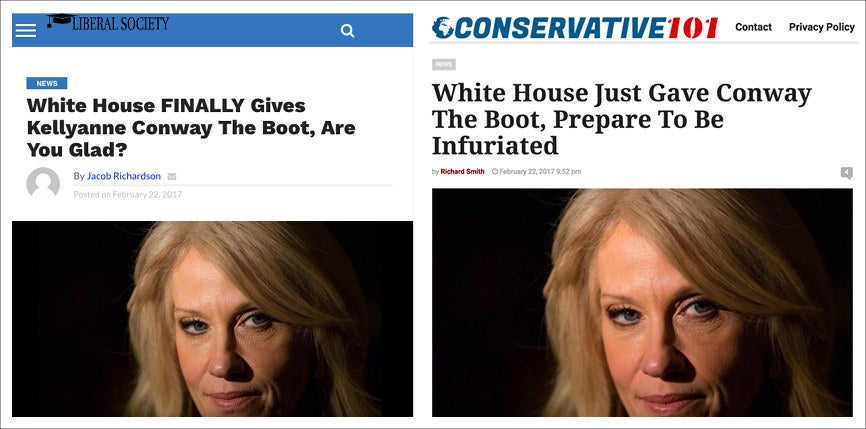
Another way that marketers, spammers, and other opportunists are cashing in on the partisan news boom is to play both sides against each other. BuzzFeed News’ research has identified at least five people or publishers who currently operate conservative and liberal websites. In each case they are part of the newer group of partisan publishers rather than long-established players. And they are often reluctant to talk to BuzzFeed News.
Freddy Hernandez of YesImRight.com, for example, at first said he didn’t have anything to do with running the site.
“I used to buy and sell domains,” he said, telling BuzzFeed News in a phone call that he sold that and other domains back in 2014.
But after being provided with evidence including Google AdSense codes and domain records that link him to YesImRight.com, Hernandez acknowledged that, yes, in fact he does run the site.
“Nothing worries me about this; I’m not ashamed of it,” he said. “It’s totally fine. I don’t see anything necessarily wrong with this. I’m just making money off a site that’s a blog or tabloid.”
During his interview with BuzzFeed News, Hernandez also acknowledged that in addition to YesImRight.com, he’s a partner in a liberal hyperpartisan site. “I don’t want to release any names, but I do have a site on the left,” he said.
Another player on both sides is a company called Income Store. Ken Courtright, its president, told BuzzFeed News that his company operates more than 3,000 websites on behalf of clients who are looking to establish their professional credibility in a specific online niche, or to make money from a website focused on a specific topic. The company operates websites about wine, dentistry, and other topics. Over the past year they launched six partisan news websites, five of which are conservative and carry names such as AmericanConservativeHerald.com, AmericanDailyPatriot.com, and MyRightAmerica.com. The lone liberal site is ProgressiveLiberal.net. Courtright told BuzzFeed News that each partisan site is operated on behalf of a different client. He said he was initially hesitant to move into political websites.
"A couple years ago somebody said, 'We have no political sites,' and I said, 'Good, keep it that way.'"

But he eventually relented, and now roughly six of his staff members are assigned to each partisan news website (in contrast, one staff member usually manages nine nonpolitical websites). The difference, he said, is their normal model relies on creating a deeply researched piece of content that will rank high in search engines. But the political sites are all about competing for attention on Facebook, which requires far more content production.
“We usually take three weeks to write a piece of authoritative content,” he said. “With these political things, I have 30 minutes. It's a totally different game.”
Courtright said he’s planning to shift the sites away from politics and more into world news to get away from the need to focus on getting traffic from Facebook. “[World news] is more Google searchable,” he said.
One notable network that plays both sides is run by two California men who are behind a website and Facebook page that time and again cropped up in BuzzFeed News’ research: American News is the fourth-largest conservative Facebook page identified in the database, and it’s the page that has seen a significant decline in Facebook engagement since November. American News also scored a top-performing link with the false story about Miley Cyrus leaving the US “for good” after Trump’s win.
“We usually take three weeks to write a piece of authoritative content. With these political things, I have 30 minutes. It's a totally different game.”
A February BuzzFeed News story revealed that AmericanNews.com’s owners, John Crane and Tyler Shapiro, operate at least two liberal websites (LiberalSociety.com, Democratic Review.com) and one other conservative site (Conservative101.com). BuzzFeed News also found that they operate the ninth-largest liberal Facebook page we gathered data from, Liberal American. Crane and Shapiro have the only company with top-10 Facebook pages on the right and the left, according to BuzzFeed News’ research. They have not replied to multiple interview requests.
The duo have continued to expand their empire on the right and the left since the first BuzzFeed News story was published. In March, they ceased uploading new content to LiberalSociety.com. DemocraticReview.com, the other liberal site cited in BuzzFeed News’ story, stopped publishing new content in May, but their Facebook pages remained active.
Soon after those sites went dormant, content from a new liberal website, DieHardDemocrat.com, started being shared on the same Liberal American Facebook page. Liberal American lists that site in its bio, as does another liberal Facebook page called Democracy Today, and yet another called We Are Liberal. These pages were previously used to share content from American News’ now-defunct liberal websites, which strongly suggests DieHardDemocrat.com is its new liberal offering. (Its domain was registered on Feb. 17 and the owner information is private. But along with the Facebook page connection, the site is hosted on the same server as AmericanNews.com and DevoutAmerica.com, which are both owned by Crane and Shapiro.)
It also appears the duo have added to their stable of conservative sites. A website called RightWingEdge.com began publishing in March and has been consistently shared on the same two Facebook pages that also share Conservative101.com content. The pages, Conservative 101 and Conservative Hub, have more than 3 million fans between them. A review of the pages by BuzzFeed News found that they appear to only share content from Conservative 101.com and RightWingEdge.com.
BuzzFeed News’ research found that it’s common for newer hyperpartisan publishers to shift to new domain names. At the end of the day, a domain name is meaningless compared to the size of the Facebook page(s) being used to send traffic to the site in order to generate the ad impressions that earn money. If you own a big Facebook page with an audience hungry for partisan news, you can send them to whatever website you want.
That fact is reinforced by the Alexa ranking charts for DieHardDemocrat.com and RightWingEdge.com. Both of these young sites have managed to rapidly climb up Alexa’s traffic rankings thanks to the firehose of traffic delivered by the liberal and conservative Facebook pages sharing their content. (The y-axis on the charts go from high number to low number because it reflects the site’s Alexa rank; for example, being the number 10 site in Alexa means you get far more traffic better than being ranked number 10,000.)
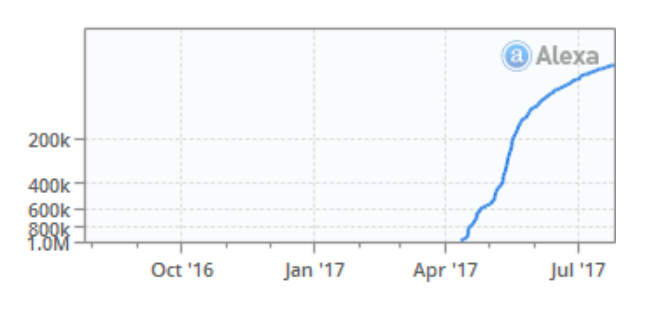

The final player on both sides identified by BuzzFeed News is another California-based publisher: Cyrus Massoumi, an outspoken critic since the election of what he says are unfair content takedowns by Facebook and the risk of censorship as the social network seeks to crack down on clickbait and misinformation.
He is publicly associated with the website Mr. Conservative, which is linked to a Facebook page with 2.2 million likes. (Mr. Conservative was one of the Facebook pages that we were unable to gather data for in our July 21 pull of the Facebook API.) But BuzzFeed News also linked him to another cluster of web properties that includes conservative sites TruthMonitor.com, PatriotBeacon.com, and WebDaily.com, as well as liberal sites LeftScoop.com and TruthExaminer.com. He did not reply to emails asking about his role with these websites.

The Money Is Rolling In
The publishers on both sides, the Macedonians, the internet marketers — many of them have converged on partisan news for the same reason: money. The exact revenue figures for websites are not disclosed by publishers, and those BuzzFeed News spoke to typically declined to offer specific figures.
But one liberal publisher with at least two websites said she grosses between $30,000 and $50,000 per month in revenue based on pageviews of between 3 million and 5 million. Conservative publisher Terry Littlepage told the New York Times Magazine that he grosses $60,000 in a “good month.”
Patrick Brown of Liftable Media declined to offer revenue figures, and the Rivero brothers who run Occupy Democrats did not respond to questions about their revenue. However, if smaller players are easily earning tens of thousands of dollars in revenue per month, it’s safe to assume that the biggest operations are well into six or even seven figures of monthly revenue.
One of the biggest expenses for Facebook-focused partisan sites is advertising. They spend money to constantly run ads for their pages that help attract new likes, and also to boost posts that are performing well. A boosted post can be targeted to specific audiences and also help grow the number of likes on a page.
The content is another expense, and many newer partisan publishers use a revenue-sharing model to pay their writers.
Documents obtained by BuzzFeed News give a sense of the income being earned by writers even before the 2016 US election presumably delivered massive increases in traffic and ad revenue. The documents list the revenue earned in three different months in 2014 and 2015 and provide a look at the money paid to writers for the group of sites run by Matthew Hanson and Daniel Gouldman of Addicting Info in 2014 and 2015.
Writers were paid based on a share of the advertising income earned from the articles they wrote. A single article page would have several ad units on it, and one ad would be linked to a Google AdSense account to pay writers. At the end of each month’s pay cycle, writers would receive a payout based on the number of impressions and clicks earned for the ads on their stories. Publishers like Hanson and Gouldman took home the rest of the revenue earned from ads on the page.
The documents obtained by BuzzFeed News list the revenue earned in three different months in 2014 and 2015.
In December 2014, according to one document, an article published on IfYouOnlyNews.com resulted in a payout for the writer of $20,026.63. That was the highest monthly payout contained in the documents.
The story in question, “I Let a Pit Bull Near My Baby: This Is What Happened (IMAGES),” generated just over 3.7 million page views. In addition to paying writers based on ad revenue, Addicting Info also had a “writers pot” that paid a flat fee per article produced. The writer of the massive pit bull post wrote only one article in December 2014. Other contributors wrote anywhere from 11 to a high of 53 posts that month. The author with 53 posts took home $11,329.30, plus an additional $865 from the writers pot.
In response to questions from BuzzFeed News, Gouldman declined to comment on the numbers. “We try not to make it a point to share personal information about what people make,” he said.
He continued, “What I can tell you is that we pride ourselves on trying to pay our people well and to the extent that someone is a capable writer — we certainly have modeled those values as an employer.”
Other liberal and conservative publishers told BuzzFeed News that the ad revenue-sharing model is common among hyperpartisan websites, though there are several large sites that pay writers by the hour or per article. Editors are typically paid per story they edit, earning $5 to $10 for each.
Since 2014, the CPMs, or cost per thousand impressions, for display ads has declined on programmatic networks such as Google AdSense. This suggests that writers today earn less money for the same amount of views than they did in 2014.
The impact of declining CPMs can be seen in the Addicting Info data for August 2015. A story published that month generated 950,000 page views and earned the writer $3,488.90. That works out to a CPM of $3.67.
However, the CPM for the December 2014 pit bull story was roughly $5.40.
Over time, some partisan websites have reduced the ad-revenue payouts to writers, while others have moved away from the model entirely. Occupy Democrats recently moved its office from Miami to Los Angeles and jettisoned many of its regular contributors in favor of staffers.
It’s now common to see job postings on Upwork and other freelance platforms looking for writers for political websites and offering pay per hour or at a set fee. A June ad on Upwork sought a writer to work seven hours per day, seven days a week for a “Republican Oriented (USA) Political Website.” “The starting monthly salary is $2,000, but if you prove to be hardworking and ready to put in the extra effort we can make a deal so both sides are satisfied,” the ad said.
The client who posted the ad has been active on Upwork since April 2016 and has earned 13 positive reviews from people they’ve hired.
Though the ad didn’t specify which website was doing the hiring, it did note the location of the employer: Veles, Macedonia. ●
How We Did This Story
BuzzFeed News began building a list of partisan sites back in the fall of 2016, as the election heated up. In early 2017, we formalized the criteria for inclusion: websites that publish American political news and that have a clear, and preferably openly stated, alignment with liberal or conservative views. We did not include mainstream news organizations such as the New York Times, NBC News, CNN, and the Wall Street Journal. Though they sometimes publish partisan opinion pieces that travel on Facebook similarly to content from hyperpartisan sites, their political news coverage is not declared to be based on a specific political point of view.
It has long been argued time that mainstream publications, due to their geographic location and staff makeup, tend to lean more liberal and therefore have a bias. That’s fair criticism. However, for this analysis we focused on publications that are clear about their political views and alignment and/or that are explicitly ideological in their identity. This also helps explain why BuzzFeed News is not included in our analysis. Our newsroom’s standards document states that political news coverage and discussions by BuzzFeed journalists should be backed up with reporting, rather than follow a specific ideological line.
To re-emphasize the point made in this story, this analysis is not based on the idea that partisan news is bad or inherently of low quality. Being on this list is not a black mark, nor is being excluded from it a sign of quality. It’s also important to acknowledge that identifying partisan sites is not an exact science. Overall, we believe the more than 600 websites in the database collectively represent the most comprehensive database of partisan websites covering American politics.
If you believe we have made a mistake in this story (such as mistakenly including a site, or miscategorized one), please contact us via this form.
Identifying and Classifying Websites
Websites were added to the list manually by two journalists who were dedicated to identifying partisan news websites. Once a website was added, its associated Facebook page was identified either by finding a link to it on the website itself or by using the CrowdTangle browser plugin to see if there was a page that shared all content from the website, and by examining a page that fit these criteria to see if it also listed the website in its bio.
Websites were classified as left- or right-leaning based on a manual review of the content published by the website and its Facebook page, and by examining their About pages for mentions of partisanship. A liberal or conservative declaration was not required for inclusion, but that element of self-identification was preferred.
Once an initial list of more than 500 websites was gathered, BuzzFeed News extracted the links on each of these websites’ homepages. We then performed a manual review of these external links to try and identify other partisan news websites that were not yet in our database.
Gathering Facebook Data
We used the Facebook API to gather all posts published by the pages from Jan. 1, 2015, until March 31, 2017. We also gathered all of the engagement data — shares, reactions, and comments — for each of these posts. On July 21, 2017, we used the API to gather the current number of fans for each page in order to have a current number of people who liked the page. That was also the date we did the final call to the Facebook API for the posts data.
What’s Missing
During the course of our research, we discovered that some Facebook pages had been removed. At least some of these were knocked out by Facebook itself during a purge of pages that were violating the terms of service.
In total, during our July 21 data pull, we were unable to gather Facebook data for 60 pages that were on our list. Some were pages that Facebook has removed. Others were "personal pages," which are akin to public-facing Facebook profiles but not accessible via Facebook's API unless the creator of that page allows it. And some pages — 24 conservative and 6 liberal, as of July 31 — were unavailable via Facebook's API at the time of our data collection but have since become available or were accessible by checking Facebook manually. None of those 30 pages would have been among the 20 most-followed pages for their respective political categories.
In gathering the post data from the API, we made a decision to exclude the engagement data for posts that were published when a page changed its cover photo. These photo posts would sometime generate engagement from page fans, but we decided to exclude them since they were not the same as photo posts published to the page with the intent of generating engagement.
One final note on the Facebook data is that we only examined pages. Partisan content is frequently shared in Facebook groups, but we did not study this area.
We inevitably we missed some partisan sites on the right and the left — new ones are launching all the time — but we believe this database is comprehensive enough to support the research and analysis contained in this report. We encourage others to access the data, to analyze it, to add to it, and to publish their own findings to help better understand the world of partisan news.
Whois Data and Google AdSense and Analytics Codes
We used DomainTools to find the date that each website domain name was registered, and we used AnalyzeID.com to identify if a website was linked to other websites via a shared Google Analytics or Google AdSense code. Because AnalyzeID does not always have the most current data, we manually checked the source code of all websites to verify the data.
We also used data from DomainTools to see if the owner of the domain said they were located in a country other than the US.
Alexa Data
Researchers at King’s College and University College London — Shehar Bano, Shweta Bhatt, Sagar Joglekar, and Nishanth Sastry — took the BuzzFeed News data set of partisan sites and used the Alexa API to access data for the available sites. Alexa upstream site data was available for 483 of the websites. Upstream sites are the sites that people visit just before going to the website in question. They are therefore key referrers that drive traffic. For the analysis, they pulled the top five upstream sites for each of the available partisan sites in Alexa.
There was an expectation of a relatively high amount of interlinking between sites given that one way sites were added to the BuzzFeed News database was by following links from one partisan site to another, or by identifying different partisan sites being shared from the same Facebook pages. However, the researchers noted, “We do not expect that these links would be among the top five drivers of traffic. Nor do we expect to see 50% of top traffic drivers to be internal links amongst the partisan websites.”
They also compared the upstream data to that of the top 500 news websites ranked by Alexa and found that this further confirmed the unique interlinking tendency between partisan sites.
Outside Your Bubble is a BuzzFeed News effort to bring you a diversity of thought and opinion from around the internet. If you don't see your viewpoint represented, contact the curator at bubble@buzzfeed.com. Click here for more on Outside Your Bubble.



